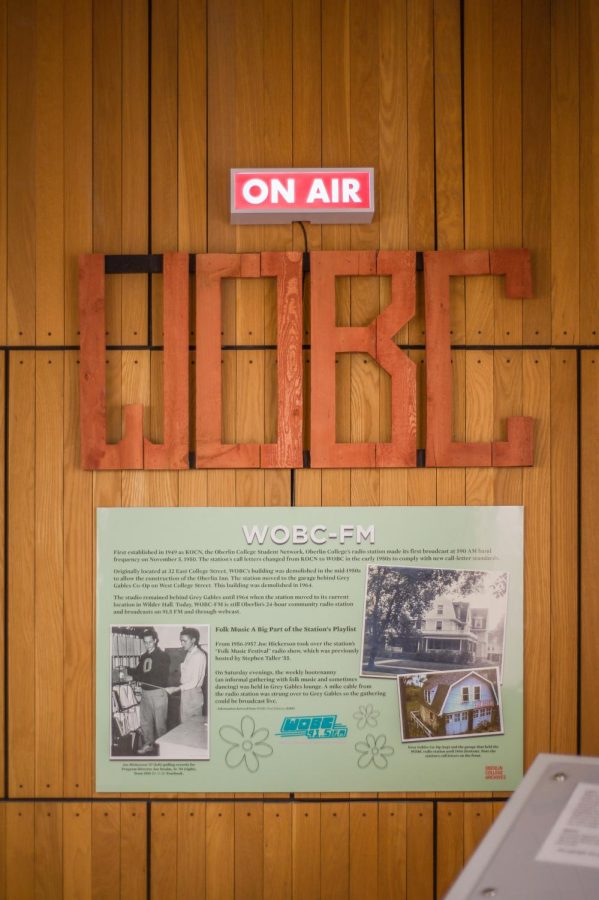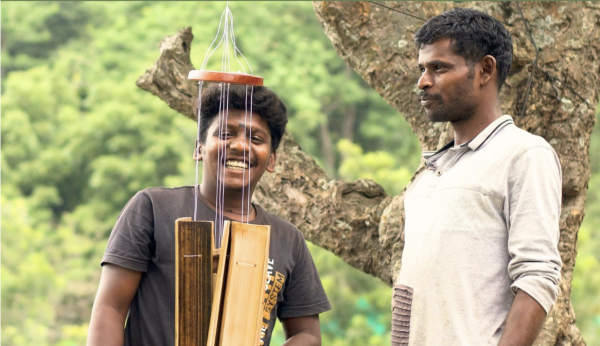Where Have All the Flowers Gone? Exhibition Opens in Mudd Center, Highlights Oberlin Folk History
Various campus libraries display Oberlin’s rich history with folk mu- sic.
The three-part exhibition Where Have All the Flowers Gone?, which runs April 14 – June 16, offers a rich exploration of Oberlin’s intimate ties to major moments and figures within folk music history. The exhibition spans three venues and examines the work of three central players in folk music: Joe Hickerson, OC ’57, in the Mary Church Terrell Main Library’s first floor gallery, Pete Seeger in the Conservatory Library, and Ed Freeman, OC ’63, in the Oberlin College Archives. Throughout the research process and selection of archived materials, College archivist Ken Grossi and Visual Resource Curator and Program Coordinator of Exhibits Heath Patten were able to locate fascinating ties between the exhibition’s three subjects. Folk music constitutes a distinctively collaborative genre, and in turn its local history illuminates a similar harmony.
A few months ago, Sid Comings, OC ’69 asked Grossi if he was interested in creating an exhibit on the life and work of Ed Freeman. Freeman, a famed photographer of Americana landscapes, began his professional career in the music industry performing as a folk guitarist and classical lutenist. As explained through the exhibition,
“Music may have been his livelihood, but shooting portraits was a secret passion.” Comings, inspired by the career of Freeman, was happy to assist in the installation of the exhibit. “I thank Ed Freeman for his generosity and his interest in the exhibit,” Comings wrote in an email to the Review. “I chuckled when he told me that I know more about him than he knows about himself.”
Grossi enthusiastically agreed to the project, and, in lieu of Comings’ facilitation of a Pete Seeger exhibit in the Oberlin Public Library, he decided to expand the exhibition to encompass Seeger’s work as well. Finally, a third wing was dedicated to Joe Hickerson, a folk singer with a fascinating history deeply intertwined with Seeger’s.
Though Hickerson studied physics during his Oberlin years, his love of folk music drove him to found the Folk Song Club in 1957. Subsequently, in May of 1957, and along with Joani Blank, OC ’59, he founded the first annual Oberlin Folk Festival. Both the club and festival were quickly cemented in Oberlin’s institutional memory; Oberlin’s Folk Festival still occurs on a yearly basis, and the Folk Song Club — now the Folk Music Club — held a performance in the exhibit’s Mudd Center wing this past Monday.
“One of [the Folk Music Club members] who is a [first-year] and played the banjo, which was Pete and Joe’s instrument of choice, said ‘The reason I came to Oberlin was because of folk history here,’” Patten said.
Hickerson, during his own first year at Oberlin, attended one of Seeger’s college tour concerts. It’s safe to say the performance ultimately altered the course of both Hickerson and Seegers’ lives.
“While [Hickerson] was here his [first] year, he saw the folk singer Pete Seeger, who was of national acclaim but had been blacklisted because of McCarthyism,” Patten said. “So he was playing college circuits. And Joe, when he saw that concert in ’54, which was in the basement of the Allen Memorial Art Museum, he said it changed everything. So he goes on to bring Pete Seeger back [to Oberlin] and becomes friends with him. Joe also had taken over a folk music show on WOBC, the College radio. But the really cool part is that he worked in the library as a student employee and he goes on to work for the Library of Congress, where he’ll be the director and the archivist for the folk song archive.”
Friendship blossomed between Hickerson and Seeger, a fact pointedly reflected by the famed song — and the exhibition’s title — Where Have All the Flowers Gone? Seeger, who was deeply influenced by Russian folk music, was working through an obscure Russian text on his plane ride to Oberlin. His reading inspired the writing of “Where Have All the Flowers Gone?”, which he first wrote and performed at Oberlin. Later, Hickerson would contribute the song’s final two verses. In the exhibition’s Mudd Center wing, a giant text displaying the lyrics to “Where Have All the Flowers Gone?” outlines Seeger’s and Hickerson’s respective verses. A station dedicated to Hickerson’s history with WOBC provides a set of dangling phone-like mechanisms wherein viewers can listen to a brief recording of Seeger jamming out with the Folk Song Club.
“Underlying all of this, Heath is going to create a panel that shows all of the collections that were used in the archives, in the Con library, that pulls us all together,” Grossi said. “That’s kind of telling especially students to say, ‘Look at all of this great material we have in our libraries that you can learn more about folk music or any other subject’.
While combing through the archives’ rich corpus, Grossi and Patten found that a fourth figure unites the exhibition’s three respective musicians. Mississippi John Hurt, an American blues singer and guitarist, makes a distinctive appearance across three disparate mediums which came to define the three figures’ professional lives. While working for the Library of Congress, one of Hickerson’s jobs was to record folk music, and one of the first musicians he recorded was Hurt. In Seeger’s late television program Rainbow Quest, which ran for 39 episodes, Hurt comes on to play a handful of blues songs and is introduced by Seeger as a “generous-hearted soul.” Freeman, who was known for housing and photographing ‘seminal musicians of the 1960s folk music revival’, according to text in the exhibiton’s Archive wing, spent time with and photographed Hurt as well. Grossi and Patten added that a photo depicting the recording session between Hurt and Hickerson will soon be featured in the exhibition. To witness the visual magic of local and historical confluence and learn more about Oberlin’s folk music history, Oberlin students and community members can visit any one of the exhibition’s three branches before they close June 16.











